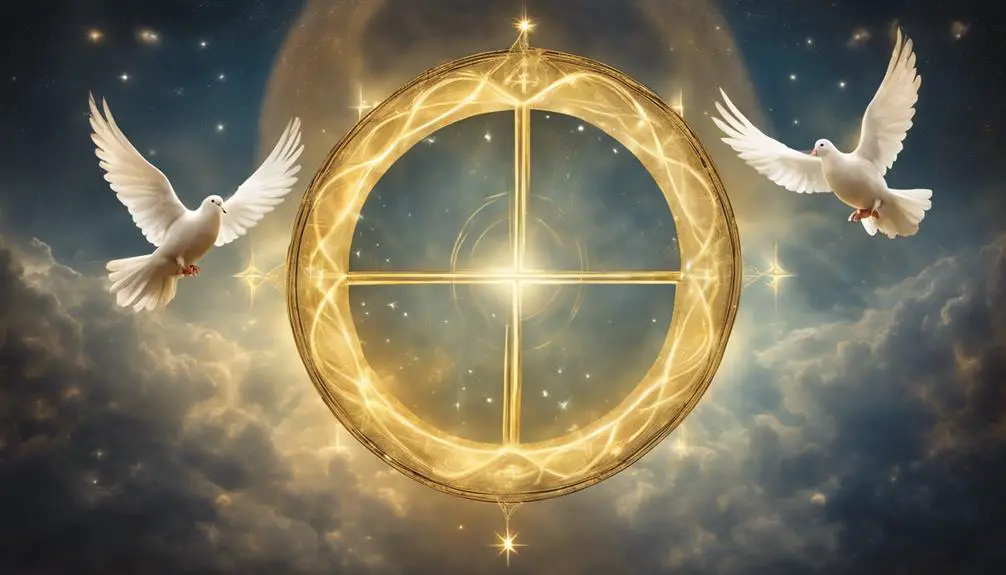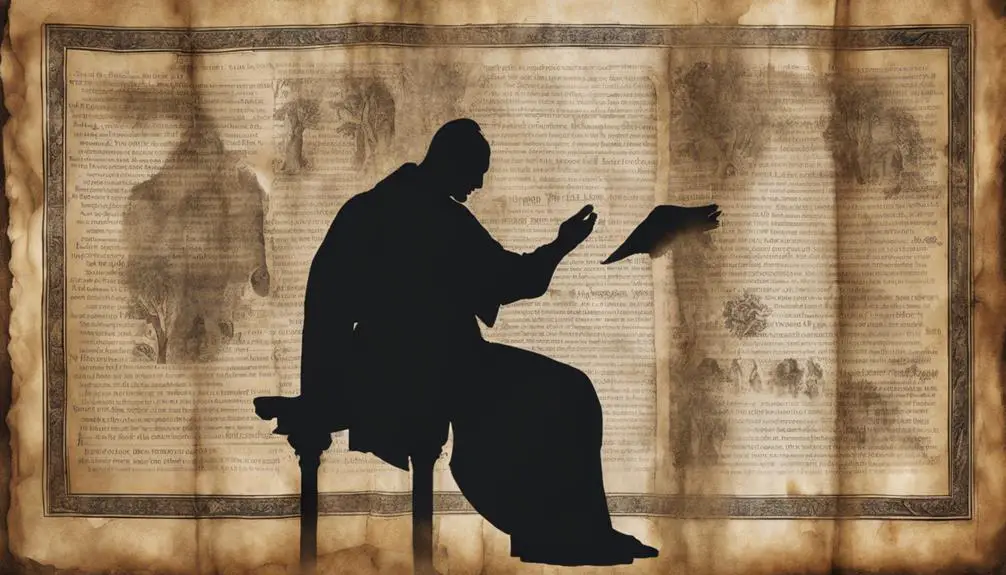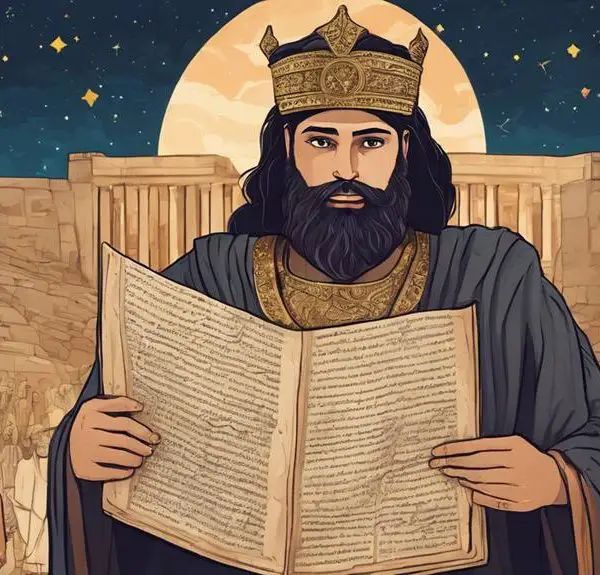Harness the hidden trilogies in the Bible to uncover divine secrets and profound meanings, waiting to be explored.
Trilogy Meaning in the Bible
Consider the concept of the Trinity in Christianity: it's a profound example of a biblical trilogy, embodying the Father, Son, and Holy Spirit as distinct but unified entities. This concept underscores a recurring theme in scripture, where triads often signify completeness and divine perfection.
You might wonder how this pattern extends beyond the Trinity to other aspects of the Bible, such as human nature, prophetic symbols, or major covenants. Exploring these triadic patterns can offer you deeper insights into the theological and philosophical underpinnings of biblical texts.
What other trilogies lie hidden within the pages, waiting for your discovery?
Key Takeaways
- The Trinity signifies unity in diversity, reflecting divine completeness and perfection.
- The threefold nature of man—body, soul, spirit—illustrates a holistic human identity.
- Biblical trilogies, like Creation-Fall-Redemption, outline the trajectory of human-divine relationships.
- The number three in prophecy and covenants underscores principles of trial, renewal, and divine promises.
The Trinity: Divine Perfection

In theological discourse, the Trinity exemplifies divine perfection, embodying a complex unity of Father, Son, and Holy Spirit within Christian doctrine. This concept, central to understanding the nature of God, represents a profound instance of unity in diversity. You'll find that the Trinity isn't merely a theological puzzle but a fundamental expression of how divine nature operates in a harmonious state, despite the distinct roles and personas.
The Trinity's essence, often perceived as an abstract notion, has tangible implications for spiritual manifestation. It underscores the belief that God's presence in the world is multifaceted yet singular in purpose and being. This duality, or rather triality, provides you with a framework to comprehend how God can be simultaneously omnipresent, incarnate in the person of Jesus, and active within the believers through the Holy Spirit.
Analyzing the Trinity through this lens reveals a balance between unity and diversity, offering a model for human relationships and community. It encourages an understanding of how distinct entities can coalesce around a shared essence or purpose. Thus, the Trinity isn't just a theological concept but a blueprint for spiritual manifestation and unity within diversity in the broader Christian experience.
Creation, Fall, Redemption
Amidst the vast narrative of the Bible, the themes of creation, fall, and redemption emerge as foundational to understanding humanity's relationship with the divine. The story begins in the Garden of Eden, where the narrative of creation unfolds, presenting a world that's 'very good' in the eyes of its Creator. This period of innocence and harmony sets the stage for the subsequent fall, a pivotal moment when humanity, through disobedience, fractures its relationship with God. This act of rebellion introduces sin and death into the world, fundamentally altering the course of human history.
The narrative doesn't end with the fall, however. The Bible consistently points toward redemption, a theme that reaches its climax in the New Testament. This redemptive arc isn't merely a return to the Garden's innocence but an ushering in of a new creation, symbolized by the Second Coming of Christ. It's through this act of divine intervention that the broken relationship between humanity and the divine is restored, offering hope of a renewed creation free from the scars of sin and death. This trilogy of creation, fall, and redemption serves as a central framework through which the Bible articulates the human experience in relation to the divine.
The Threefold Nature of Man

The concept of the threefold nature of man, encapsulating spirit, soul, and body, offers a profound lens through which to explore human identity and its multifaceted relationship with the divine. This tripartite understanding emphasizes the complexity and depth of the human experience, suggesting a unique integration of existential components that interact with and inform each other.
Consider the following aspects:
- Spirit: The aspect that connects us to the divine, enabling communion and spiritual discernment. It's through the spirit that one perceives the transcendental, seeking a higher purpose beyond the physical realm.
- Soul: Soul exploration delves into the realm of emotions, intellect, and will. It's the seat of our desires, thoughts, and feelings, playing a critical role in shaping our personality and moral compass. The soul embodies the psychological aspects of human existence, offering a bridge between the spirit and the body.
- Body: The physical vessel that allows interaction with the material world. Body significance extends beyond mere biological functions; it's through the body that spiritual beliefs and emotional states find expression in actions and practices.
Analyzing the threefold nature of man uncovers the intricate balance and interplay between these components, each contributing to a holistic understanding of what it means to be human in relation to the divine.
Major Covenants in Threes
Exploring the Bible reveals a pattern of divine commitment through three major covenants, each establishing a unique framework for understanding God's relationship with humanity. These covenants, rooted in historical contexts, are pivotal for interpreting the biblical narrative's scope and the unfolding of divine promises.
The first of these, the Noahic Promise, emerges in the aftermath of the flood. This covenant establishes a universal sign of divine mercy and commitment to sustain life on earth, irrespective of humanity's failures. It's a promise of preservation, symbolized by the rainbow, assuring that destruction on such a scale wouldn't recur.
Moving forward, the covenant with Abraham introduces the concept of a chosen people. Through Abraham's Seed, God promises not just to form a distinct nation but also to bless all nations of the earth. This covenant is foundational for understanding the lineage through which the biblical narrative unfolds, emphasizing faith and obedience as key components of the relationship between God and His people.
These covenants, alongside the subsequent Mosaic covenant, form a trilogy of divine promises that shape the biblical story's trajectory. They offer a lens through which one can understand the complexity of God's interactions with humanity, highlighting themes of mercy, selection, and covenantal faithfulness.
Symbolism of Three in Prophecy
Delving into biblical prophecy, one can't overlook the profound symbolism of the number three, a motif that recurs with significant theological implications. This symbolism isn't arbitrary; it's deeply woven into the fabric of biblical narratives, serving as a cornerstone in understanding the divine messages and prophecies conveyed throughout the scriptures.
Consider the following examples that highlight the symbolism of three in biblical prophecy:
- Three Temptations of Jesus: This pivotal event, where Jesus is tempted three times by Satan in the wilderness, underscores the theme of trial and triumph. Each temptation represents a deeper spiritual truth about reliance on God, the misuse of power, and the importance of worship, setting a precedent for overcoming worldly trials through faith.
- Prophetic Visions in Daniel: Daniel's prophecy is rich with the symbolism of three, including the three-week period he mourns before receiving a significant vision. These instances underscore periods of preparation, waiting, and revelation in the divine plan.
- Jonah's Three Days in the Whale: Symbolizing death, reflection, and rebirth, this narrative aligns with the motif of three, representing a journey of transformation and deliverance, echoing the resurrection after three days, a cornerstone event in Christian theology.
These examples illustrate how the symbolism of three in prophecy isn't merely a recurring number but a profound symbol that enriches the interpretative framework of biblical narratives, offering insights into divine principles and the fulfillment of God's promises.
Frequently Asked Questions
How Has the Concept of a Trilogy in Biblical Context Influenced Modern Literature and Storytelling?
In modern literature and storytelling, the trilogy framework has deeply influenced narrative techniques and the structure of modern adaptations.
You'll see that authors and creators often use a triadic structure to build complexity, enhance character development, and create a more satisfying arc.
This approach not only pays homage to classical storytelling traditions but also leverages the power of three to enrich narratives, making them more engaging and memorable for audiences.
Are There Any Other Major Religions or Mythologies That Have Similar Trilogy Concepts as Found in the Bible?
Yes, major religions and mythologies outside of Christianity feature concepts similar to a trilogy.
For example, Hinduism has the Trimurti, representing the three aspects of the divine through Brahma, Vishnu, and Shiva.
Similarly, Norse mythology includes triads, such as the three Norns who govern fate.
These examples show how the structure of a trilogy, embodying multiple facets of a single concept, is a recurring theme across various belief systems.
How Do Biblical Scholars Reconcile the Concept of Trilogies With the Overarching Narrative of Monotheism in Christianity?
You're exploring how scholars harmonize trilogies with Christianity's monotheism. They delve into Trinitarian debates, scrutinizing historical and theological discussions to understand this balance.
Through scholarly analysis, they offer Monotheistic interpretations that view the Trinity not as three separate gods but as one God in three persons. This approach maintains Christianity's monotheistic core while embracing its complex theological traditions, providing a nuanced understanding of how these concepts coexist.
What Are the Specific Linguistic or Numerical Significance of the Number Three in Ancient Hebrew Culture, Outside of the Biblical Narratives?
You're diving into the significance of the number three in ancient Hebrew culture, and it's not just about counting sheep. Mathematical patterns and architectural influences reveal the depth of three's importance.
Ironically, while you might expect a straightforward answer, the complexity unfolds like a meticulously designed tapestry. This number's prominence echoes through various cultural aspects, from design principles to societal structures, showcasing a blend of analytical thought and scholarly insight.
Can the Trilogy Structure Found in the Bible Be Connected to Psychological or Philosophical Theories of Human Cognition and Perception?
You're exploring how the trilogy structure might align with theories of human cognition and perception.
It's intriguing to consider the 'three stages' of development or understanding within a 'cognitive trinity' framework. This approach suggests that our minds naturally organize information into triads, potentially mirroring the trilogy's narrative structure.
Analyzing this connection could offer insights into why trilogies are compelling and resonate deeply with human psychological and philosophical patterns of thought.
Conclusion
So, you've waded through the biblical trios: the Trinity, humanity's dramatic arc, our complex nature, and those triple-layered covenants, not to mention the prophetic love for the number three.
It seems the good book might've had a slight obsession with trilogies long before Hollywood caught on. Analyzing these patterns reveals not just a divine preference for thirds but a narrative technique that's as old as time, offering depth, rhythm, and a scholarly nod to the power of three.



Sign up